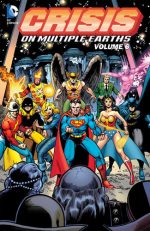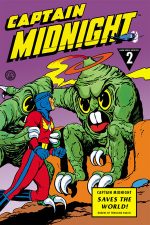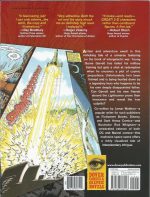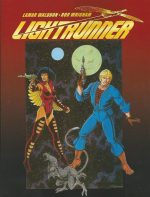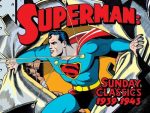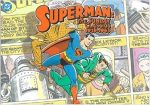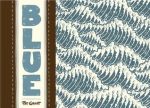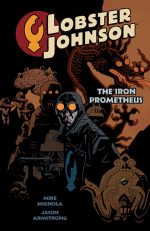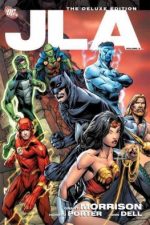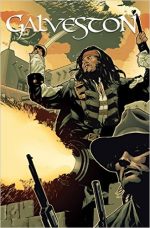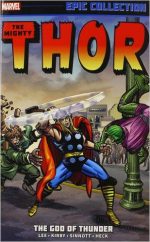
By Stan Lee, Jack Kirby, Larry Lieber, Robert Bernstein, Joe Sinnott, Al Hartley, Don Heck & various (Marvel)
ISBN: 978-0-7851-8835-3
Even more than the Fantastic Four, The Mighty Thor was the arena in which Jack Kirby’s restless fascination with all things Cosmic was honed and refined through his dazzling graphics and captivating concepts. The King’s string of power-packed signature pantheons began in a modest little fantasy/monster title called Journey into Mystery where – in the summer of 1962 – a tried-and-true comicbook concept (feeble mortal transformed into god-like hero) was revived by the fledgling Marvel Comics to add a Superman analogue to their growing roster of costumed adventurers.
This gloriously economical full-colour tome – also available in eFormats – re-presents those pioneering Asgardian exploits from JiM #83-109, spanning summer 1962 to October 1964 in a blur of innovation and seat-of-the-pants myth-revising and universe-building…
Cover-dated August 1962, Journey into Mystery #83 saw a bold costumed warrior jostling aside the regular fare of monsters, aliens and sinister scientists in a brash, vivid explosion of verve and vigour.
The initial exploit followed crippled American doctor Donald Blake who takes a vacation in Norway only to encounter the vanguard of an alien invasion. Fleeing, he is trapped in a cave where he finds an old, gnarled walking stick. When in his frustration he smashes the stick into a huge boulder obstructing his escape, his puny frame is transformed into the Norse God of Thunder, the Mighty Thor!
Plotted by Stan Lee, scripted by his brother Larry Lieber and illustrated by Kirby and inker Joe Sinnott (at this juncture a full illustrator, Sinnott would become Kirby’s primary inker for most of his Marvel career), ‘The Stone Men of Saturn’ is pure early Marvel, bombastic, fast-paced, gloriously illogical and captivatingly action-packed. The hugely under-appreciated Art Simek was the letterer and logo designer.
It was clear that they whey were making it up as they went along – not in itself a bad thing – and that infectious enthusiasm shows in the next adventure…
‘The Mighty Thor Vs. the Executioner’ is a “commie-busting†tale of its time with a thinly disguised Fidel Castro wasting his formidable armies in battle against our hero. Dr. Blake’s nurse Jane Foster is introduced; a bland cipher adored from afar by the Norse superman’s timid alter-ego. The creative team settled as Dick Ayers replaced Sinnott, and with #85’s ‘Trapped by Loki, God of Mischief!’ the final element fell into place with the “return†of a suitably awesome arch-foe; in this case the hero’s half-brother. This evil magician and compulsive trickster escaped divine incarceration and his first thought was to bedevil Thor by causing terror and chaos on the world of mortals he was so devoted to.
Here a new and greater universe was first revealed with the tantalising hints and glimpses of the celestial otherworld and more Nordic gods…
Issue #86 introduced another recurring villain. Zarrko, bristling at the sedentary ease of 23rd century life, travelled to 1962 to steal an experimental “C-Bombâ€, forcing the Thunderer into a stirring hunt through time and inevitable clash with super-technology ‘On the Trail of the Tomorrow Man!’ On his return Blake became a target of Soviet abductors. Those sneaky spies even managed to make Thor a ‘Prisoner of the Reds!’ before eventually emerging unscathed and triumphant…
‘The Vengeance of Loki’ saw the god of Mischief’s return in #88 as the malevolent miscreant uncovered Thor’s secret identity and naturally menaced Jane Foster whilst ‘The Thunder God and the Thug’ was adventure on a much more human scale wherein a gang boss runs riot over the city and roughshod over a good woman’s heart, giving the Asgardian a chance to demonstrate a more sophisticated and sympathetic side by crushing him and freeing her from Thug Thatcher‘s influence.
Issue #90 was an unsettling surprise as the grandeur of Kirby & Ayers was replaced by the charming yet angst-free art of Al Hartley, who illustrated Lee & Lieber’s stock alien-invasion yarn ‘Trapped by the Carbon-Copy Man!’ A month later the Storm Lord tackles ‘Sandu, Master of the Supernatural!’, with Sinnott handling all the art, in a thriller starring a carnival mentalist who – augmented by Loki’s magic – comes catastrophically close to killing our hero…
Sinnott drew JiM #92’s ‘The Day Loki Stole Thor’s Magic Hammer’ (scripted by Robert Bernstein over Lee’s plot) which moves the action fully to the mythical realm of Asgard for the first time as Thor sought to recover his stolen weapon after Loki ensorcelled the magnificent mallet. Kirby & Ayers momentarily returned for Cold War/Atom Age thriller ‘The Mysterious Radio-Active Man!’ – again plotted by Bernstein – as Mao Tse Tung unleashes an atomic assassin in retaliation for Thor thwarting China’s invasion of India. Such “Red-baiting†was common in early Marvel titles, but their inherent jingoistic silliness can’t mar the eerie beauty of the artwork. With this tale the rangy, raw-boned Thunder God completed his slow metamorphosis into the husky, burly blonde bruiser who dominated any panel he was drawn in.
Sinnott illustrated the next three somewhat pedestrian adventures. ‘Thor and Loki Attack the Human Race!’, ‘The Demon Duplicator’ and ‘The Magic of Mad Merlin!’, but these mediocre tales of magic-induced amnesia, science-fuelled evil doppelgangers and an ancient mutant menace were the last of an old style of comics. Stan Lee took over full scripting with Journey into Mystery #97 and a torrent of action wedded to soap opera melodrama resulted in a fresh style for a developing readership.
‘The Lava Man’ in #97 was again drawn by Kirby, with the subtly textured inking of Don Heck adding depth to the tale of an invader summoned from the subterranean realms to menace humanity at the behest of Loki. More significantly a long running rift between Thor and his stern father Odin was established after the Lord of Asgard refused to allow his son to love the mortal Jane.
This acrimonious triangle was a perennial sub-plot fuelling many attempts to humanise Thor, because already he was a hero too powerful for most villains to cope with. Most importantly this issue was notable for the launch of a spectacular back-up series. ‘Tales of Asgard – Home of the mighty Norse Gods’ gave Kirby a vehicle to indulge his fascination with legends. Initially adapting classic tales but eventually with all-new material particular to the Marvel pantheon, he built his own cosmos and mythology, which underpinned the company’s entire continuity. This first saga, scripted by Lee and inked by George Bell (AKA old Golden Age collaborator George Roussos), outlined the origin of the world and the creation of the World Tree Yggdrasil.
‘Challenged by the Human Cobra’ introduced the serpentine villain (bitten by a radioactive Cobra, would you believe?) in a tale by Lee & Heck, whilst Kirby – with them in attendance – offered ‘Odin Battles Ymir, King of the Ice Giants!’ a short, potent fantasy romp which laid the groundwork for decades of cosmic wonderment of years to come.
The same format held for issues #99 and #100 with the main story (the first two-part adventure in the run) introducing the brutal ‘Mysterious Mister Hyde’ – and concluding a month later with ‘The Master Plan of Mr. Hyde!’ The modern yarn dealt with a contemporary chemist who could transform into a super-strong villain at will and who framed Thor for his crimes whilst in primordial prehistory Kirby detailed Odin’s war with ‘Surtur the Fire Demon’ and latterly (with Vince Colletta inking) crafted an exploit of the All-Father’s so different sons in ‘The Storm Giants – a tale of the Boyhood of Thor’. As always, Lee scripted these increasingly influential comicbook histories…
JiM #101 saw Kirby finally assume control of the pencilling on both strips. ‘The Return of Zarrko, the Tomorrow Man’ sees Odin halve Thor’s powers for wilful disobedience just as the futuristic felon abducts the Thunder God to help him conquer the 23rd century. Anther two-parter (the first half inked by Roussos), it was balanced by another exuberant tale of the boy Thor. ‘The Invasion of Asgard’ sees the valiant lad fight a heroic rearguard action that introduced a host of future villainous mainstays such as Rime Giants and Geirrodur the Troll.
‘Slave of Zarrko, the Tomorrow Man’ is a tour de force epic conclusion most notable for the introduction of Chic Stone as inker. To many of us oldsters, his clean, full brush lines make him The King’s best embellisher ever.
This triumphant futuristic thriller is counterbalanced by brooding short ‘Death Comes to Thor!’ as the teen hero faces his greatest challenge yet. Two females who would play huge roles in his life were introduced in this brief 5-pager; the young goddess Sif and Hela, Queen of the Dead.
On a creative roll, Lee, Kirby & Stone next introduced ‘The Enchantress and the Executioner’: ruthless renegade Asgardians determined to respectively seduce or destroy the warrior prince in the front of JiM #103 whilst the rear revealed ‘Thor’s Mission to Mirmir’ disclosing how the gods created humanity. That led one month later to a revolutionary saga when ‘Giants Walk the Earth’.
For the first time Kirby’s imagination was given full play after Loki tricks Odin into visiting Earth, only to release ancient elemental enemies Surtur and Skagg, the Storm Giant from Asgardian bondage.
This cosmic clash saw noble gods battling demonic evil in a new Heroic Age, and the greater role of the Norse supporting cast – especially noble warrior Balder – was reinforced by a new Tales of Asgard strand focussing on individual Gods and Heroes. ‘Heimdall: Guardian of the Mystic Rainbow Bridge’ was first, with Heck inking.
Issues #105-106 saw the teaming of two old foes in ‘The Cobra and Mr, Hyde’ and ‘The Thunder God Strikes Back’; another continued story packed with tension and spectacular action, proving Thor was swiftly growing beyond the constraints of traditional single issue adventures. The respective back-ups ‘When Heimdall Failed!’ (Lee, Kirby & Roussos) and ‘Balder the Brave’ (Lee, Kirby & Colletta) further fleshed out the back-story of an Asgardian pantheon deviating more and more from those classical Eddas and Sagas kids had to plough through in schools.
Journey into Mystery #107 premiered a petrifying villain in ‘When the Grey Gargoyle Strikes’, a rare yarn highlighting the fortitude of Dr. Blake rather than the power of the Thunder God, who was increasingly reducing his own alter-ego to an inconsequentiality. Closing the issue, the Norn Queen debuted in a quirky reinterpretation of the classic myth ‘Balder Must Die!’ illustrated by Kirby & Colletta.
After months of manipulation the God of Evil once again took direct action in ‘At the Mercy of Loki, Prince of Evil!’ With Jane a helpless victim of Asgardian magic, the willing assistance of new Marvel star Doctor Strange made this a captivating team-up to read, whilst ‘Trapped by the Trolls’ (Colletta inks) showed the power and promise of tales set solely on the other side of the Rainbow Bridge after Thor liberates Asgardians from Subterranean bondage.
Bringing down the curtain on this increasingly cosmic carnival, Journey into Mystery #109 was another superb adventure masquerading as a plug for recent addition to the Marvel roster.
‘When Magneto Strikes!’ pits Thor against the X-Men‘s greatest foe in a cataclysmic clash of fundamental powers, but you couldn’t really call it a team-up since the heroic mutants are never actually seen. The tantalising hints and cropped glimpses are fascinating teasers now, but the kid I then was felt annoyed not to have seen these new heroes… oh… wait… maybe that was the point?
The Young Thor feature ‘Banished from Asgard’ is an uncharacteristically lacklustre effort to end on as Odin and Thor enact a devious plan to trap a traitor in Asgard’s ranks but the vignette hinted at much greater thrills to follow…
These early tales of the God of Thunder show the development not only of one of Marvel’s core narrative concepts but, more importantly, the creative evolution of perhaps the greatest imagination in comics. Set your common sense on pause and simply wallow in the glorious imagery and power of these classic adventures for the true secret of what makes comicbook superheroes such a unique experience.
© 1962, 1963, 1964, 2014 Marvel Characters, Inc. All rights reserved.

